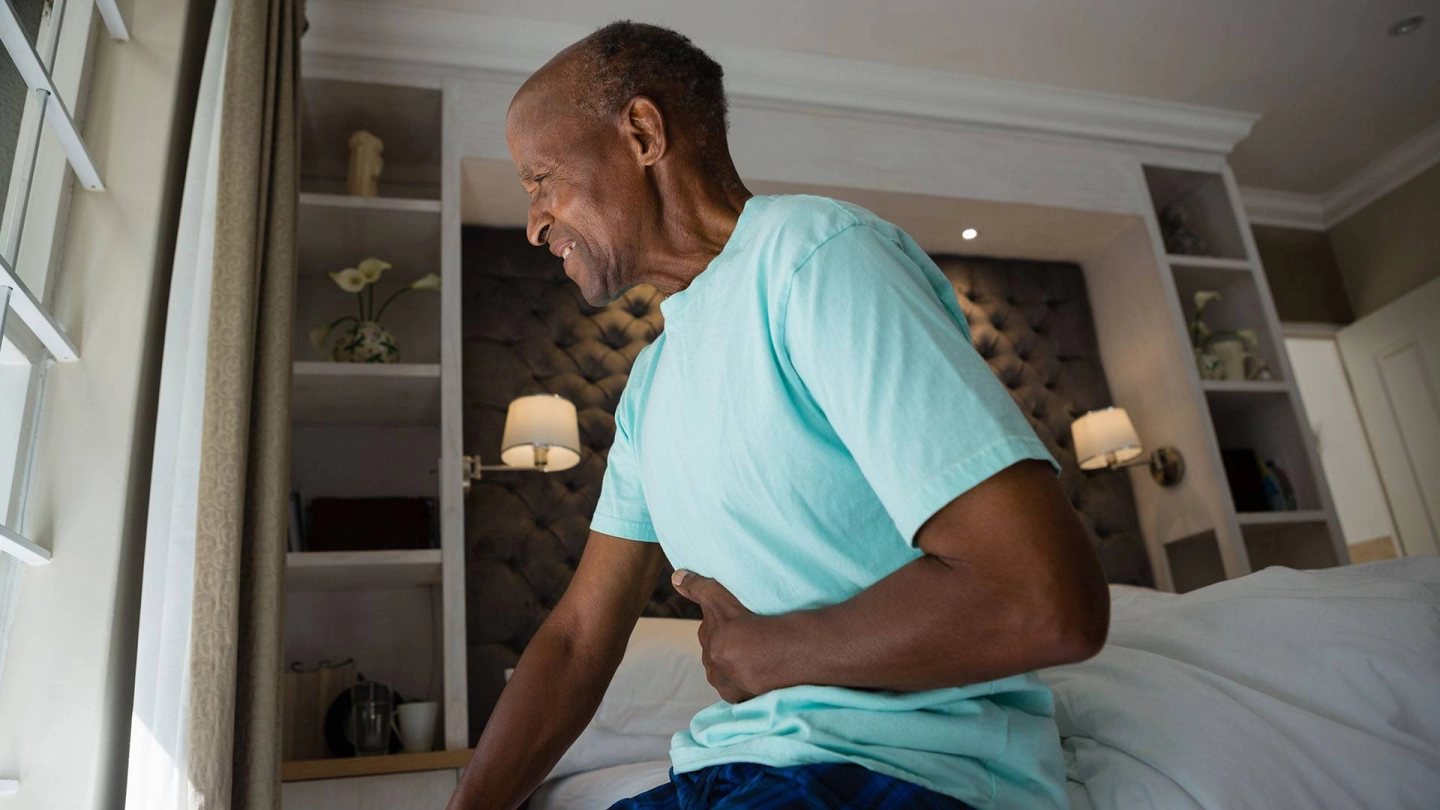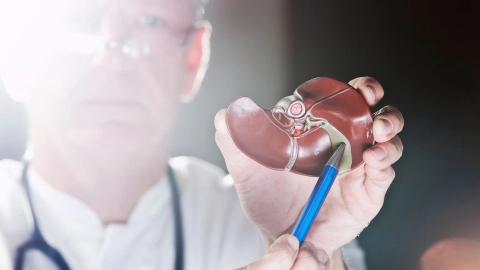Conditions Obstruction of the gallbladder
ICD codes: K82.0 What are ICD codes?
Gallbladder obstructions are usually caused by gallstones or constricted bile ducts. Symptoms include spasmodic pain in the upper abdomen. An untreated obstruction of the gallbladder can lead to inflammation. Drugs or surgical measures help, however.
At a glance
- With an obstruction of the gallbladder, bile fluid accumulates because it cannot flow in or out.
- Common causes include gallstones and constricted or occluded bile ducts.
- Severe spasmodic pain in the upper abdomen is considered a typical symptom of a gallbladder obstruction.
- If the accumulation of fluid is not treated, the gallbladder or bile ducts can become inflamed.
- Doctors usually diagnose an obstruction of the gallbladder with the aid of an ultrasound examination.
- The gallbladder is often removed for long-term relief of symptoms.
Note: The information in this article cannot and should not replace a medical consultation and must not be used for self-diagnosis or treatment.

What is an obstruction of the gallbladder?
The gallbladder is a small hollow organ located somewhat below the liver in the right-hand part of the abdominal cavity.
The liver produces up to a liter of yellow-green to brownish bile fluid (bile) every day. This flows through the bile ducts into the gallbladder, where it is condensed and stored.
Where necessary, bile is carried from the gallbladder through the common bile duct into the small intestine, where it breaks down the fats from food to help the intestines absorb them. The bile thus supports digestion, especially of fatty food.
Components of bile are salts, water, cholesterol, fats and coloring agents like bilirubin. Bilirubin develops in the liver during the decomposition of red blood cells.
An obstruction of the gallbladder occurs when the bile ducts are obstructed, preventing bile fluid from flowing in and out. The main cause is gallstones.
What are the symptoms of an obstruction of the gallbladder?
While many people with gallstones have no or few symptoms, an obstruction of the gallbladder usually causes general discomfort and moderate to severe pain. This occurs in the right upper abdomen and may spread to the right shoulder or back.
This pain is often paroxysmal or spasmodic. It is therefore also referred to as biliary colic. It is typical for the pain to initially be more severe and last at least 30 minutes. It then recedes again until it has completely vanished after a few hours. Such colics appear at intervals, but not necessarily daily.
Other possible symptoms of a gallbladder obstruction are:
- nausea
- vomiting
- sweating
- flatulence
- intolerance of food, especially fatty and spicy foods
- fever
- weight loss
If the obstruction of the gallbladder also affects the liver function, signs of this are moreover jaundice, somewhat yellow skin or mucous membranes and dark urine.
What causes an obstruction of the gallbladder?
Possible reasons for obstructed bile ducts and obstruction of the gallbladder are:
- gallstones and bile sludge, both in the gallbladder and the bile ducts
- abdominal injuries
- acute or chronic inflammation of the bile ducts, gallbladder or pancreas
- impaired blood supply to the bile duct
- an injury to the bile ducts, which can occur for instance during a gallbladder examination
- rare: result of a bacterial infection of the bile ducts
It is rare for a predisposition to gallbladder obstruction to be congenital. LPAC syndrome for instance has genetic causes. LPAC is an abbreviation for low phospholipid-associated cholelithiasis. People with this syndrome already develop gallstones from cholesterol in their younger years.
Video How do gallstones develop?
Watch this video to find out how gallstones develop and what symptoms they may cause.
This and other videos can also be found on YouTube
Watch nowThe privacy policy indicated there applies.
Which factors increase the risk of an obstruction of the gallbladder?
Factors that increase the risk of a gallbladder obstruction include:
- little physical activity
- high-calorie, low-fiber diet
- being overweight and obese
- severe weight loss
- prolonged artificial diet
- chronic diseases like type 2 diabetes
- existing inflammation of the gallbladder or bile ducts
- increased values of specific factors in the blood, for instance cholesterol
- gender: disorders of the gallbladder occur more commonly in women than men
- pregnancy
- taking a birth control pill that contains the sex hormone estrogen
- genetic predisposition: diseases of the gallbladder occur frequently in the family
What are the possible consequences of an obstruction of the gallbladder?
With an obstruction of the gallbladder, a lot of fluid occasionally accumulates in front of or in the gallbladder. Left untreated, this may cause acute or recurrent inflammation of the bile ducts or gallbladder or pancreatitis.
Furthermore, the risk of liver diseases, such as chronic inflammations or pus accumulations (abscesses), increases.
How can an obstruction of the gallbladder be prevented?
Regular physical activity can prevent a gallbladder obstruction. It is also helpful to have a balanced and healthy diet and maintain a normal body weight.
If risk factors like being overweight, a lack of exercise or a genetic predisposition are known, doctors may use cholesterol-lowering drugs (statins).
After severe weight loss, for example due to a diet or surgical sleeve gastrectomy, there is an increased probability of gallstones forming. The active substance ursodeoxycholic acid can then – taken over a limited period – prevent gallstones or even dissolve small gallstones.
How is an obstruction of the gallbladder diagnosed?
Among other things, the severity of the symptoms for a gallbladder obstruction depends on how long the obstruction has already been present. Furthermore, the gallbladder or bile ducts may have already become inflamed.
People with pain due to an obstruction of the gallbladder consult a family doctor or proceed directly to the emergency department of a hospital.
In both situations, it is important to describe all symptoms accurately. Doctors begin with a physical examination by palpating the abdomen. People with a gallbladder obstruction often react defensively because the pressure on the gallbladder is unpleasant. That is an initial reference point for diagnostic findings in the gallbladder.
With an ultrasound examination of the abdomen, doctors can detect changes to the gallbladder and blocked bile ducts. Larger gallstones can also be detected in this way.
Sometimes nothing can be detected during an ultrasound of the abdominal wall. If there is nevertheless a suspicion of gallstones or bile sludge in the bile ducts or gallbladder, endosonography, an ultrasound examination in the interior of the body, is performed. This is done by inserting a thin, flexible endoscope into the stomach and intestines via the mouth so that the organs such as the gallbladder or pancreas can be examined at close range.
Alternatively, doctors use magnetic resonance cholangiography (MRC) and computed tomography (CT). Both methods enable them to create accurate images of the internal organs so they can detect inflamed bile ducts more successfully than with an ultrasound examination, for example.
In addition, blood can be taken and various values determined in a laboratory. For example, the content of enzymes like lipase is important. These proteins are responsible for fat digestion and are usually transported to the intestines via the bile ducts. If this path is blocked, there will be increased lipase values in the blood.
An increased bilirubin value is also an indication of an obstruction of the bile ducts, because the yellowish-brown bile pigment often does not drain off adequately via the bile ducts.
In young people with a suspected gallbladder obstruction, a genetic analysis may show whether a genetic predisposition for gallstones exists.
How is an obstruction of the gallbladder treated?
A gallbladder obstruction often causes symptoms that must be treated. That is especially the case when bile ducts, the gallbladder or other organs have become inflamed.
Drugs, endoscopic procedures or surgical measures are used for treatment.
Drug therapy
Non-steroidal anti-inflammatory drugs such as Diclofenac help counter pain. Doctors may try to dissolve small gallstones or deposits in the gallbladder with the active substance ursodeoxycholic acid. It is important for the gallbladder to be otherwise healthy and function well.
If bacteria have caused an inflammation of the gallbladder or bile ducts, these are treated with appropriate antibiotics.
Endoscopic procedures
Bile duct stones are usually removed in the course of an endoscopic retrograde cholangiography (ERC). In the process, a flexible tube or thin metal tube – the endoscope – is pushed forward through the mouth, stomach and small intestine into the bile ducts. A contrast medium is then injected. This makes the bile ducts visible in an X-ray examination.
If the gallbladder also still contains stones, it can be surgically removed later to prevent complications. An ERC causes complications such as inflammation of the pancreas or injuries to the bile duct and gastrointestinal tract in about 5 to 10% of people.
Surgical interventions
The gallbladder is often surgically removed after an obstruction or inflammation. This surgery is called a cholecystectomy. Doctors usually remove the gallbladder through a small opening in the abdominal wall.
If the gallbladder is inflamed or severe pain occurs, a cholecystectomy is carried out within 24 to 72 hours of the diagnosis.
Sometimes, it is not possible to determine a reason for an obstruction of the gallbladder but serious and recurrent symptoms still manifest themselves. In such cases, doctors also often remove the gallbladder.
Important: It is possible to live well and eat normally even without a gallbladder. Only after particularly fatty meals do symptoms like flatulence or diarrhea sometimes occur.
- Deutsche Gesellschaft für Gastroenterologie, Verdauungs- und Stoffwechselkrankheiten e.V. (DGVS) und Deutsche Gesellschaft für Allgemein- und Viszeralchirurgie e.V. (DGAV). Prävention, Diagnostik und Behandlung von Gallensteinen. S3-Leitlinie. AWMF-Registernummer 021/008. 11.2017.
- DynaMed (Internet), Ipswich (MA). Gallstones. EBSCO Information Services. Record No. T114033. 2018 (1995). Aufgerufen am 09.12.2021.
- Jones MW, Deppen JG. Gallbladder Mucocele. [Updated 2021 Sep 20]. In: StatPearls [Internet]. Treasure Island (FL): StatPearls Publishing; 2021 Jan-. Aufgerufen am 09.12.2021.
- Wanjara S, Kashyap S. Bile Duct Stricture. [Updated 2021 June 5]. In: StatPearls [Internet]. Treasure Island (FL): StatPearls Publishing; 2021 Jan-. Aufgerufen am 09.12.2021.
- UpToDate (Internet). Functional gallbladder disorder in adults. Wolters Kluwer 2020. Aufgerufen am 09.12.2021.
In cooperation with the Institute for Quality and Efficiency in Health Care (Institut für Qualität und Wirtschaftlichkeit im Gesundheitswesen – IQWiG).
As at:





